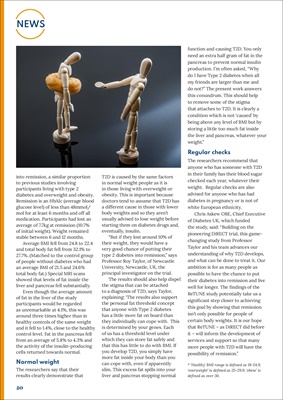
20
NEWS
into remission, a similar proportion
to previous studies involving
participants living with type 2
diabetes and overweight and obesity.
Remission is an HbA1c (average blood
glucose level) of less than 48mmol/
mol for at least 6 months and off all
medication. Participants had lost an
average of 7.7kg at remission (10.7%
of initial weight). Weight remained
stable between 6 and 12 months.
Average BMI fell from 24.8 to 22.4
and total body fat fell from 32.1% to
27.7%. (Matched to the control group
of people without diabetes who had
an average BMI of 21.5 and 24.6%
total body fat.) Special MRI scans
showed that levels of fat inside the
liver and pancreas fell substantially.
Even though the average amount
of fat in the liver of the study
participants would be regarded
as unremarkable at 4.1%, this was
around three times higher than in
healthy controls of the same weight
and it fell to 1.4%, close to the healthy
control level. Fat in the pancreas fell
from an average of 5.8% to 4.3% and
the activity of the insulin-producing
cells returned towards normal.
Normal weight
The researchers say that their
results clearly demonstrate that
T2D is caused by the same factors
in normal weight people as it is
in those living with overweight or
obesity. This is important because
doctors tend to assume that T2D has
a different cause in those with lower
body weights and so they aren't
usually advised to lose weight before
starting them on diabetes drugs and,
eventually, insulin.
"But if they lost around 10% of
their weight, they would have a
very good chance of putting their
type 2 diabetes into remission," says
Professor Roy Taylor, of Newcastle
University, Newcastle, UK, the
principal investigator on the trial.
The results should also help dispel
the stigma that can be attached
to a diagnosis of T2D, says Taylor,
explaining: 'The results also support
the personal fat threshold concept
that anyone with Type 2 diabetes
has a little more fat on board than
they individually can cope with. This
is determined by your genes. Each
of us has a threshold level under
which they can store fat safely and
that this has little to do with BMI. If
you develop T2D, you simply have
more fat inside your body than you
can cope with, even if apparently
slim. This excess fat spills into your
liver and pancreas stopping normal
function and causing T2D. You only
need an extra half gram of fat in the
pancreas to prevent normal insulin
production. I'm often asked, "Why
do I have Type 2 diabetes when all
my friends are larger than me and
do not?" The present work answers
this conundrum. This should help
to remove some of the stigma
that attaches to T2D. It is clearly a
condition which is not 'caused' by
being above any level of BMI but by
storing a little too much fat inside
the liver and pancreas, whatever your
weight."
Regular checks
The researchers recommend that
anyone who has someone with T2D
in their family has their blood sugar
checked each year, whatever their
weight. Regular checks are also
advised for anyone who has had
diabetes in pregnancy or is not of
white European ethnicity.
Chris Askew OBE, Chief Executive
of Diabetes UK, which funded
the study, said: "Building on the
pioneering DiRECT trial, this gamechanging
study from Professor
Taylor and his team advances our
understanding of why T2D develops,
and what can be done to treat it. Our
ambition is for as many people as
possible to have the chance to put
their diabetes into remission and live
well for longer. The findings of the
ReTUNE study potentially take us a
significant step closer to achieving
this goal by showing that remission
isn't only possible for people of
certain body weights. It is our hope
that ReTUNE - as DiRECT did before
it - will inform the development of
services and support so that many
more people with T2D will have the
possibility of remission."
* 'Healthy' BMI range is defined as
18-24.9; 'overweight' is defined as 25-
29.9; 'obese' is defined as over 30.